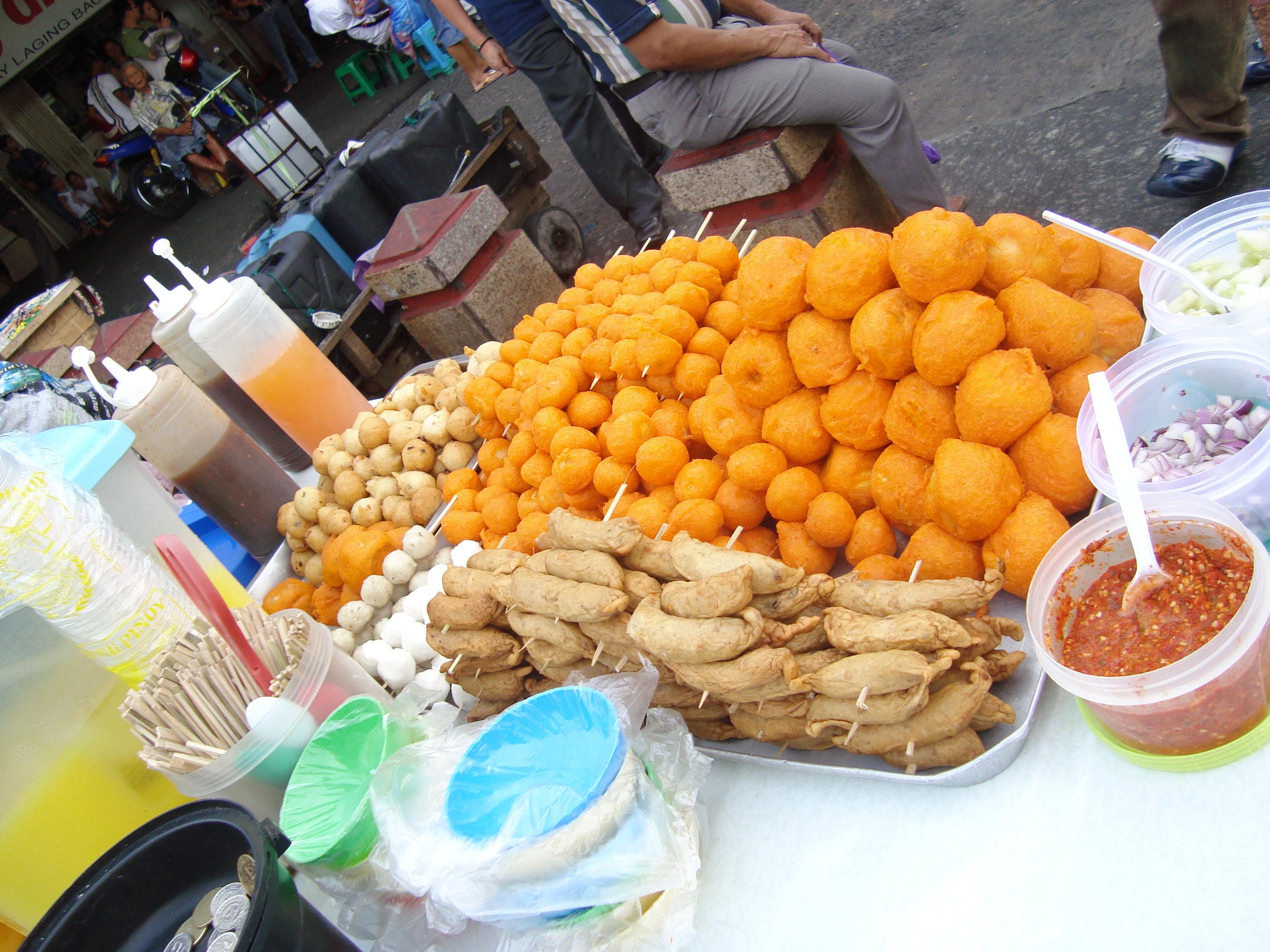
Street food in Manila, Philippines
Street food is very common in the Philippines. It can be found in any road around the country, that is why Filipinos are very fond with it. It’s an important part of the Filipino culture.
Street food is a ready-to-eat food or drink sold at the streets or other public place, such as a market or fair, by a hawker or vendor, often from a portable stall.
Foreigners shouldn’t miss to try and taste the best-tasting street food in the Philippines during their visit. Street food is a favorite merienda and pasttime of all Filipinos wherever they go. It is easy to eat and very affordable. For a small price, one can have merienda packed with food on a stick and some refreshing drinks.
Common Street Foods in the Philippines
The most common Philippine street foods include fried squidballs, fishballs, kikiam—a type of processed chicken and pork, which is served on a stick, with a variety of dips and sauces.
Roadside stands also serve barbecued pork, chicken and offal, such as pig's blood or dried chicken blood (colloquially, Betamax after its rectangular shape resembling the Betamax tape), chicken heads (helmet), chicken feet (adidas), pig's ears (tenga), and chicken intestines (isaw). Among more esoteric food are balut and penoy (duck eggs; with fetus and without, respectively), tokneneng and kwek-kwek (battered, deep-fried chicken and quail eggs similar to Tempura) and deep-fried day-old chick.
Taho, a type of soft beancurd served with syrup and tapioca balls is another snack, as are other offerings, such as burgers, hot dogs, and cotton candy.
Palamig (literally, coolers) are also sold, such as traditional offerings like halo-halo and fruit juices. Sorbetes (or, colloquially "dirty ice cream," locally-produced usually with coconut milk as popularly called Pinoy sorbetes ice cream in flavors such as mango, cheese and yam) and Halo-Halo - a Filipino cold treat made up of crushed ice with fruits (nata de coco, kaong or palm fruit, jackfruit meat, sweet beans, mung beans, yam, macapuno - gelatinuous coconut meat, tapioca, and jelly, with skim milk and toppings - usually rice crispies, leche flan, and ice cream) bring nostalgia to Filipinos.
Calamares (battered squid pieces deep-fried in cooking oil and a lot cheaper than the traditionally available) is also widely consumed throughout the country. It is gaining its popularity because of its cheap price.
Top Street Foods in the Philippines
Fishballs, Squidballs, Chicken balls and Kikiam
- The most commonly eaten type of fish balls is colloquially known simply as fishballs. It is somewhat flat in shape and most often made from the meat of cuttlefish or pollock and served with a sweet and spicy sauce or with a thick, black, sweet and sour sauce.
- A recent trend in the Philippine fishball industry is the introduction of 'ball' varieties: chicken, squid (cuttlefish actually), and kikiam.
Camote Cue, Turon and Banana Cue
- Deep fried bananas and sweet potato coated in caramelized brown sugar are a popular snack food in the Philippines. Banana cue is made from Saba bananas while camote cue is made from sweet potato. It is usually skewered on a bamboo stick, and is sold on the streets usually in the afternoon which is perfect for merienda. A banana wrapped in a lumpia wrapper is called turon.
Kwek-kwek
- Kwek-kwek is a kind of food commonly sold along the streets in the Philippines. It is made up of hard-boiled chicken eggs individually wrapped in orange-tinted batter, which are then fried until golden brown. There is another version of the kwek-kwek called the tokneneng (or tuknene) which uses quail eggs instead of chicken eggs.
Barbecue
- Grilled street food is a favorite “Pulutan” of Filipino. It includes Isaw, seasoned hog or chicken intestines; betamax, roasted dried chicken blood served cut into and served as small cubes for which it received its name in resemblance to a Betamax tape; and Adidas, chicken feet named after the popular shoe brand “Adidas”.
Adidas
- Adidas or chicken feet are marinated in a mixture of calamansi, spices and brown sugar before being grilled. A popular staple in Philippine street food, chicken feet are commonly known as "adidas".
- Deep fried adidas coated with cornstarch are also sold in the street as a favorite street food.
Calamares
- A fried breaded squid chopped like a ring is a famous street food for many and a favorite pulutan in a drinking session.
Binatog
- It is a Filipino food sold in the street on a bicycle. It is made of boiled corn and mixed with salt and coconut gratings.
Balut
- A balut is a fertilized duck embryo that is boiled and eaten in the shell. It is commonly sold as streetfood in the Philippines.
Taho
- Taho is a Philippine delicacy made of fresh soft/silken Tofu, Arnibal (brown sugar syrup), and Sago "pearls" (which are similar to Tapioca pearls). This staple comfort food is a signature sweet; and can be found all over the Philippines.
Iskrambol
- A local icy concoction, Iskrambol is composed of crushed ice, pieces of diced colored gelatin, sago and condensed milk or powdered milk and sugar, mixed together using an egg beater and topped with chocolate syrup.
Sorbetes
- Sorbetes is the traditional variation of ice cream made in the Philippines. It is distinct from the similarly named sorbet. Peddled by street hawkers, it is usually served with small wafer or sugar cones and more recently, bread buns. It is uniquely made from coconut milk, unlike other iced desserts that are made from animal milk.
- http://en.wikipedia.org/wiki/List_of_street_food
- http://en.wikipedia.org/wiki/List_of_street_food#Philippines
- http://en.wikipedia.org/wiki/Fish_ball#Philippines
- http://en.wikipedia.org/wiki/Banana_cue
- http://en.wikipilipinas.org/index.php?title=Kwek-kwek
- http://en.wikipedia.org/wiki/Barbecue
- http://en.wikipedia.org/wiki/Chicken_feet#Philippine_cuisine
- http://en.wikipedia.org/wiki/Philippine_cuisine#Street_food_and_other_snacks
- http://en.wikipilipinas.org/index.php?title=Taho
- http://en.wikipilipinas.org/index.php?title=Top_10_Filipino_Street_Foods
- http://en.wikipedia.org/wiki/Sorbetes
- http://tl.wikipedia.org/wiki/Binatog
- http://en.wikipedia.org/wiki/Balut_(egg)
- http://www.philippinecountry.com/philippine_street_foods.html









